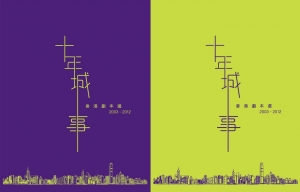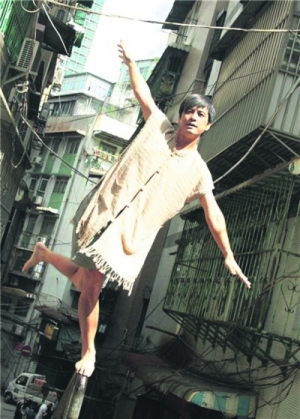2025年9月
Nine years ago, I left the media where I was a cultural and theatre critic, for another role that I knew would take some of the gripping or heartwarming performances I had seen out of my memories, and into a public space. There, anyone from schools to researchers to future theatre makers and critics could watch them, alive and intact, well into the future.
Part of my job at Esplanade – Theatres on the Bay includes managing its audiovisual archives, which have cultural and historical significance for Singapore and Asia. Over 23 years, the arts centre has not only been one of the region’s busiest presenters of theatre, music and dance, but also very active as a commissioner and producer of new work.
It has been quite the journey towards proper storage and cataloguing of our performance recordings and releasing a curated selection online. After one content microsite (Esplanade Offstage, launched a few months before COVID at end-2019), a move to a new media asset management system, and changes to our organisational policies, processes and contracts, we are finally able to launch Replay – Screenings from the Esplanade Archives, in conjunction with Singapore’s 60th birthday. Over 30 recordings of memorable past performances are available to watch for free up till 31 March 2026. It is the most extensive archival release to date of performances commissioned, produced or presented by Esplanade, featuring a wide range of Singapore companies as well as Asian and international groups such as Pichet Klunchun Dance Company, Cloud Gate Dance Theatre of Taiwan and Akram Khan Company. Seeking to watch an Esplanade work for research or educational purposes that is not in Replay? You can email us for limited-duration access to the archival recording.
Close partnership with arts companies and their archives has also made possible a new long-running physical exhibition at Esplanade, Idea to Stage, on the ideas, worldbuilding, soundscapes and costumes that have gone into some of the arts centre’s significant theatre productions. This is special for me because exhibitions dedicated to the performing arts and its history are rare in Singapore – the last theatre exhibition I saw here was in 2012 at the Peranakan Museum, on the much-revived classic Emily of Emerald Hill.
Archival has not just been an institutional journey, but a personal one. In wrapping my head around the task, I grew other professional limbs, rewired part of my brain’s circuitry and learned to collaborate across disciplines. The critic works independently to flesh out contexts, cut through the noise to make connections and judge with love and clear-eyed intentionality. The archivist, on the other hand, is embedded within an organisation. You are not just a custodian of the past who needs to be immersed in all its sociocultural nuances, but also a forward-looking problem solver who must keep pace with the latest systems and technologies.
Archival has been a sector-wide journey in Singapore, a land-scarce city-state where the pace of development is as breakneck as its people are forgetful. For research on the arts, the National Library’s Arts Collection has been indispensable – I’ve watched DVDs of landmark homegrown theatre works from the 1980s and 1990s on the multimedia stations in their reference library, and prominent artists have donated manuscripts and other ephemera to the collection. Other noteworthy archives here for theatre are Centre 42 and the archives of storied theatre companies The Necessary Stage and T:>Works, which make digitised materials such as programme booklets and posters accessible online.
Yet the archive is only one way of remembering and reliving performances. Through docu-theatre, theatre makers in Singapore have been using live performance to keep stoking the flames of theatre history. At least two of the works screened in Replay fall into this category. In the Ong Keng Sen musical National Broadway Company (2012), actors playing theatre personalities share the tales of grit and soul searching behind the early English-language musicals here (available to watch on Esplanade Offstage from 10 October 2025). Toy Factory Productions’s All the World Is One’s Stage (2021) dramatises the oral histories of four Chinese-language theatre veterans, including their awakenings and heartbreaks living through turbulent times. Then there is Mari Kita Main Wayang (2023), a play-within-a-play where iconic wayang Peranakan performer G. T. Lye shares nuggets on that once-vibrant traditional theatre of the Straits Chinese community which uses the Baba Malay patois. Collectively a snapshot of the cultural and linguistic diversity of theatre in Singapore, these works can be viewed online for a limited time, in full or as excerpts.
Left: A scene from Mari Kita Main Wayang (Photo: Crispian Chan, photo courtesy of Esplanade – Theatres on the Bay)
Right: At the Idea to Stage exhibition, with Mari Kita Main Wayang’s director Alvin Tan and performer G.T. Lye, looking at the production’s costumes (designed by Max Tan) (Photo courtesy of Esplanade – Theatres on the Bay)
This essay looks at the necessity and challenges of the performance archive as well as ‘performance as archival’ in the Singapore context.
The ‘who’, ‘why’ and ‘how’ of archival
Throughout the history of Singapore, theatre has always been part of how people in a multiethnic, multicultural society unwind and advocate for change – from street performances of bangsawan (Malay opera) and Chinese wayang, to 1930s Chinese-language plays rallying the local Chinese and raising funds for China’s wartime resistance against the Japanese. From the 1990s, after some three decades of independence and a growing economy, several trends found expression in the theatre. Creative individuals hungered to express alternative views. A growing middle class desired to feel seen through what they watched and read. The government began to grant the arts in general more leeway as a safe space for questioning, and more funding in order to inspire audiences and connect Singapore to the world.
After many years of watching and writing about theatre and other art forms here, I realised that without a deliberate and systematic process of archival and documentation, there would only ever be knee jerk and insufficiently considered responses to a work of art. Everything would always be the ‘first’ based on the viewer encountering it for the first time. The ephemeral nature of live performance, designed to be experienced in the moment, doesn’t help. In a compact city-state with a small audience base, runs of theatre productions are often just a few days and at most two or three weeks’ long, though significant works may have had numerous lives through the years, at home and abroad.
The work of a performance archivist has some parallels with his or her museum counterparts – collections managers and conservators – yet the conditions of the work are also quite different. While storage, cataloguing and conservation practices go hand in hand with the acquisition and display of museum objects from day one, performing arts centres and performance companies don’t start out thinking of their works as a ‘collection’. Archival is usually an afterthought, something that only comes much later when they realise they have a history worth preserving. The work of performance archival is specialised at one end and menial at the other. Digital storage can be costly and physical storage comes at a premium in tiny Singapore. Filming a performance entails additional costs and considerations – depending on the quality of the recording that is desired, what works for live in terms of design and direction has to be rethought and adapted for film. If the end goal is streaming or broadcast, the use of copyrighted material costs significantly more than for live performance and requires additional clearances.
One of the first things my colleagues and I did was to work out Esplanade’s archival policy, to answer the question of who we are archiving for, what should be archived and how. From the outset, we determined that we were archiving primarily for the purposes of reference, education and communication. As nothing conveys a performance better than the moving image, we prioritised the digital archival of performance recordings. Finally, we decided that we would be very selective about investing in better quality recordings for streaming or broadcast – the work in question would have to be commissioned or produced by Esplanade, all producing partners including the artists must agree to that outcome, and ideally, we would have a broadcast or filming partner to spread out costs and maximise reach. Very few live arts companies anywhere have the wherewithal to operate like Britain’s National Theatre, where the international star power of its productions have made possible the creation of a dedicated income stream of made-for-broadcast recordings, National Theatre Live.
Many types of shows happen at Esplanade. Companies hire our venues for their shows. For other shows, Esplanade is the presenter but was not involved in the creation of the work. Then there are the works in which Esplanade has put resources to create (a process known as ‘commissioning’) and produce. The degree of ‘ownership’ thus shapes our archival policy, influencing everything from the quality of filming to how long we keep the recordings. With the help of our technical production colleagues, we have set up single-camera recordings for all performances in our venues, but these are very rudimentary recordings that are strictly for reference purposes. Multi-camera archival is done selectively, and my team works closely with the centre’s programmers – responsible for all our live programmes – on such filming.
While digital content has contributed greatly to Esplanade’s reach and viewership in the years since COVID, most of this is made-for-digital, in the form of behind-the-scenes or educational videos and articles on artists and art forms. One of our most-viewed video series is Cargo Lift Sessions, where we film prominent music artists from around the world performing in Esplanade’s cargo lift. Archival recordings of live performances are only one component of the digital content we create. The most notable of such initiatives is our filming and streaming on YouTube and Esplanade Offstage of choice gigs by Singapore and Asian indie music luminaries from the annual alternative music festival Baybeats.
Playing out lived histories of artists
All performing arts companies and arts centres wishing to archive their history must grapple with the nuts and bolts of systems and processes, which are challenging for us as not-for-profit companies with limited resources. That aside, theatre makers have used the medium of performance itself to ‘archive’ or document theatre history from the artists’ perspective. As fellow critic Corrie Tan wrote in Jom in January 2024, “Singapore theatre indulges, fairly often, in theatre about itself”, noting that such independent and creative modes of documentary performance “offers … safety from the flattening forces of a state and a mainstream media that often present themselves as the authoritative chroniclers of a Singaporean experience”.
Left: Margaret Leng Tan in a scene from Dragon Ladies Don’t Weep (Photo: Crispian Chan, photo courtesy of Esplanade – Theatres on the Bay)
Right: Johnny Ng 黄家强 in All The World Is One’s Stage 《一个人的舞台》 (Photo: Tuckys, photo courtesy of Esplanade – Theatres on the Bay)
Oral history, however, can have its own flattening effect onstage – the danger is falling into a pit of wordy monologues that audiences can’t climb out of. The best moments in such docu-performances are three-dimensional, when the text works in concert with elements such as the sound, set, lighting, multimedia and, of course, the performer’s face, body, movements and gestures to flesh out an artist’s lived experience. That is what happens in Dragon Ladies Don’t Weep, a solo performance by New York-based Singapore artist and grande dame of experimental music Margaret Leng Tan, where a non-linear narrative, live music performed by Tan and evocative multimedia design all become a portal into an inimitable artist’s memories, fears and obsessions. Co-produced by Australian arts company Chamber Made and CultureLink Singapore, and co-commissioned by and staged at Esplanade in 2021 and 2022, Dragon Ladies Don’t Weep has won international awards and is still touring, so we were not able to screen the archival recording of the performance. What we have online as part of Replay, however, is an illuminating documentary film in which Tan and the creative team reflect on the making of the work. A podcast on the making-of process and a display of Nick Roux’s multimedia designs for the work are also part of the Idea to Stage exhibition at Esplanade.
Another flash of performative insight can be found in All the World Is One’s Stage when veteran actor Johnny Ng dramatises his adolescent self attending his first family ‘conference’ where he is told he has to leave school and find a job – the unlicensed taxi that his father has been driving has been impounded, and he has already completed primary school unlike his brothers. Ng does a pitch-perfect impression of his mother trying to act blasé as she delivers this news, even as through his/her eyes you can see the bottom of her son’s dreams fall out. In this way, the actor conveys with the economy of a look and a few gestures the resignation and desperation of a family trying to make ends meet in hardscrabble times. The effect is similar to a live work-in-progress showing of Last Rites that I watched at the end of 2024, by Singapore theatre makers Chong Tze Chien and Liu Xiaoyi, featuring five ageing master performers from different parts of Asia, all at the peak of their powers, sharing their life stories. Last Rites was not an Esplanade production – it was staged at the Nanyang Academy of Fine Arts Studio Theatre – but there are some parallels with All the World Is One’s Stage, not least in that both productions featured and told the story of Yang Shibin, another veteran Singapore Chinese-language theatre actor.
Even as such works usually start out from interview or oral history transcripts, the resulting productions have to mitigate the ‘talkiness’ of the source material. One way is to harness the full-bodied craft of the performer at its heart, but another is to play with the theatrical form itself and create conversations between the past and present. Inspired by the format of Broadway musical A Chorus Line in which individual dancers share their hopes and regrets while auditioning for a spot in the chorus of a musical, the tongue-in-cheek National Broadway Company posits a fictitious Singapore which has established a National Broadway Company. As the who’s-who of the local theatre industry vie for the role of its artistic director, actors playing the likes of composer Dick Lee, director Ong, actresses Pam Oei and the late Emma Yong[1] all spill the stories of their formative years, and sing well-loved songs from past musicals. Seated at a piano, millennial musician Benjamin Kheng – who plays Lee – launches into the jaunty rhythms of ‘Fried Rice Paradise’ with its Singlish-infused lyrics and local references, then tells you about Lee’s identity crisis after writing the song (in 1974) when it was banned from local radio (presumably because of the use of non-standard English, frowned upon at the time). In his own words, Lee went on to “bury my Singapore identity” by trying to write like a white guy, leading to a fateful moment one day in London when a music publisher asked him, “What have you got to say as an Asian?”. This juxtaposition of the songs with oral history brings new shades of meaning to familiar musical numbers, while also shedding light on the wrestling of identity and other trials and tribulations behind the early homegrown English-language musicals.
Benjamin Kheng in a scene from National Broadway Company (Photo: Jack Yam, photo courtesy of Esplanade – Theatres on the Bay)
Remembering as a community
At the live production run of National Broadway Company in 2012 (it was one of several works commissioned to mark Esplanade’s 10th anniversary as an arts centre), audience members were invited to vote via SMS for their favourite candidate for artistic director of this fictitious National Broadway Company. The audience’s applause and laughter can also be heard at various points through the archival recording of the production. It is a reminder that live performance is a communal activity, and that for such works of docu-performance, we are remembering and processing our memories and feelings as a community.
Global trends indicate that archival is also headed in the direction of being an open, communal space, and this goes beyond offering searchable online access to an archive. In May 2025, British design museum V&A unveiled the V&A East Storehouse, a funky four-storey east London complex in which visitors can explore over half a million objects in the museum’s collection and see conservators at work on everything from paintings to puppets.
My personal dream for Esplanade’s archives is that it could one day be part of such a community space after we have completed the organisation of our physical archives of posters, programme booklets and other print materials in a few years’ time. Alongside a space for performance-related exhibitions and talks that could be programmed by the arts centre along with partners, I can picture a reference area for the Esplanade archives with a multimedia station and browsable collections. Hopefully, this dream can one day become reality.
[1] Aside from acting in numerous homegrown musicals through the 1990s and 2000s, good friends Oei and Yong, along with Selena Tan, were the founding members of popular Singapore cabaret trio Dim Sum Dollies. Yong passed away at the age of 37 from stomach cancer in 2012.
本網站內一切內容之版權均屬國際演藝評論家協會(香港分會)及原作者所有,未經本會及/或原作者書面同意,不得轉載。















